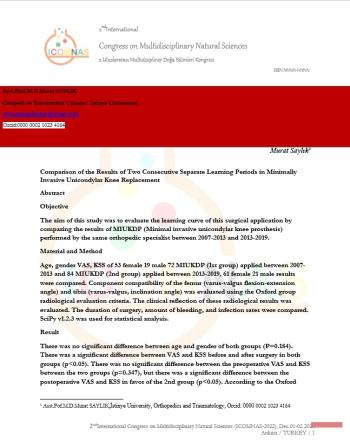
Comparison of the Results of Two Consecutive Separate Learning Periods in Minimally Invasive Unicondylar Knee Replacement
Abstract
Objective
The aim of this study was to evaluate the learning curve of this surgical application by comparing the results of MIUKDP (Minimal invasive unicondylar knee prosthesis) performed by the same orthopedic specialist between 2007-2013 and 2013-2019.
Material and Method
Age, gender VAS, KSS of 53 female 19 male 72 MIUKDP (1st group) applied between 2007-2013 and 84 MIUKDP (2nd group) applied between 2013-2019, 61 female 21 male results were compared. Component compatibility of the femur (varus-valgus flexion-extension angle) and tibia (varus-valgus, inclination angle) was evaluated using the Oxford group radiological evaluation criteria. The clinical reflection of these radiological results was evaluated. The duration of surgery, amount of bleeding, and infection rates were compared. SciPy v1.2.3 was used for statistical analysis.
Result
There was no significant difference between age and gender of both groups (P=0.184). There was a significant difference between VAS and KSS before and after surgery in both groups (p<0.05). There was no significant difference between the preoperative VAS and KSS between the two groups (p=0.347), but there was a significant difference between the postoperative VAS and KSS in favor of the 2nd group (p<0.05). According to the Oxford group radiological evaluation criteria, there was no significant difference between the two groups. There was a significant difference in favor of the 2nd group in the duration of the operation (p<0.05) and the amount of bleeding (p<0.05).
Dıscussıon
The MIUKDP learning curve was long. As the number of cases increased, significant improvement was observed in the amount of bleeding, VAS and KSS. There was a significant difference in favor of Group 2 in the duration of the operation and the amount of bleeding.
Keywords: Knee, Minimally invasive, Unicondylar, Prosthesis, Learning



